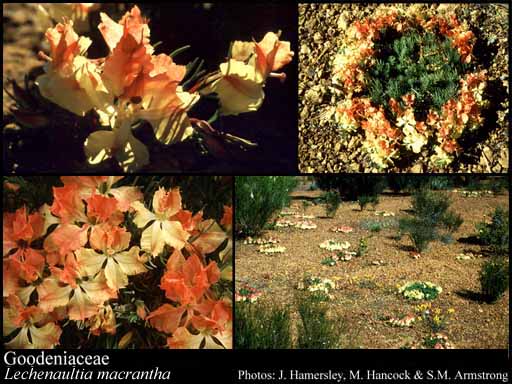- Reference
- Prodr.Fl.Nov.Holland. 573 (1810)
- Name Status
- Current







Scientific Description
Common name. Leschenaultia Family.
Habit and leaf form. Herbs, or shrubs, or trees (a few). ‘Normal’ plants, or switch-plants (rarely spinescent); sometimes with the principal photosynthesizing function transferred to stems (spines or cladodes). Leaves well developed, or much reduced. Plants spiny, or unarmed. Annual, or perennial; plants with a basal concentration of leaves, or with neither basal nor terminal concentrations of leaves. Mesophytic, or xerophytic. Leaves alternate (nearly always), or opposite to whorled (rarely); nearly always spiral; ‘herbaceous’, or membranous; petiolate to sessile; non-sheathing; simple; epulvinate. Leaf blades pinnately veined. Leaves without stipules. Leaf blade margins entire, or serrate, or dentate. Leaves without a persistent basal meristem. Leaf anatomy. Complex hairs present, or absent. Complex hairs when present, often stellate. Stem anatomy. Nodes unilacunar, or tri-lacunar, or penta-lacunar. Secondary thickening absent, or developing from a conventional cambial ring.
Reproductive type, pollination. Fertile flowers hermaphrodite. Unisexual flowers absent. Plants hermaphrodite. Entomophilous. Pollination mechanism conspicuously specialized (involving cupular or bifid stylar modifications for active pollen presentation).
Inflorescence and flower features. Flowers solitary, or aggregated in ‘inflorescences’; in cymes, in spikes, in heads, and in racemes. The terminal inflorescence unit cymose, or racemose. Inflorescences scapiflorous, or not scapiflorous; terminal, or axillary; pseudanthial, or not pseudanthial. Flowers small to medium-sized; very irregular (mostly), or regular (Brunonia); mostly zygomorphic. The floral asymmetry involving the perianth and involving the androecium. Flowers 5 merous; cyclic; tetracyclic. Free hypanthium absent. Hypogynous disk present, or absent. Perianth with distinct calyx and corolla; (8–)10; 2 -whorled; isomerous, or anisomerous. Calyx (3–)5 (usually small); 1 -whorled; gamosepalous. Corolla 5; 1 -whorled; appendiculate (the lobes usually winged, and the posterior lobes auriculate in e.g. Dampiera), or not appendiculate; gamopetalous; lobed. Corolla tube not noticeably adaxially split (rarely), or adaxially deeply split (often more or less to the base). Corolla lobes valvate; unequal but not bilabiate (then adaxially split to the base), or bilabiate, or regular (Brunonia); white, or yellow, or blue, or orange, or pink (or brownish). Androecium 5. Androecial members free of the perianth, or adnate (to the corolla tube); all equal; free of one another (but the anthers usually connivent), or coherent (the anthers connate); 1 -whorled. Androecium exclusively of fertile stamens. Stamens 5. Staminal insertion near the base of the corolla tube. Stamens isomerous with the perianth; oppositisepalous; all alternating with the corolla members. Anthers separate from one another (e.g. Velleia, Scaevola), or cohering, or connivent (encircling the style, which presents to insects by growing up through them, carrying pollen in a ‘cup’); dehiscing via longitudinal slits; introrse; tetrasporangiate. Pollen shed in aggregates (sometimes), or shed as single grains; that of Lechenaultia, in tetrads. Gynoecium 2 carpelled. The pistil 1 celled, or 2 celled, or 4 celled. Gynoecium syncarpous; synstylovarious to eu-syncarpous; superior to inferior. Ovary unilocular, or plurilocular; (1–)2 locular (the septum incomplete above in Brunonia), or 4 locular (rarely). Locules without ‘false septa’ (usually), or secondarily divided by ‘false septa’ (rarely, in Scaevola). Gynoecium stylate. Styles 1 (with a ‘pollen cup’ close beneath the stigma); bearing an ‘indusium’ beneath the stigma. Indusium cupular, or two-lipped. Styles apical. Stigmas 1, or 2; 2 - lobed; dry type; papillate; Group II type. Placentation when more or less unilocular, basal (or on the basal septum of the incompletely divided ovary); usually axile. Ovules in the single cavity when applicable, 1; 1–50 per locule (to ‘many’); ascending; non-arillate; anatropous.
Fruit and seed features. Fruit fleshy, or non-fleshy; dehiscent, or indehiscent; a capsule, or a drupe, or a nut. Seeds copiously endospermic. Endosperm oily. Seeds usually flat, winged, or wingless. Cotyledons 2. Embryo straight. Seedling. Germination phanerocotylar.
Physiology, biochemistry. Aluminium accumulation not found.
Geography, cytology, number of species. World distribution: mainly Australia and Malaysia, but a few species in coastal South America and Africa, West Indies, New Zealand and Southeast Asia. X = 7–9. 300 species.
Keys
Key to the Goodeniaceae of Western Australia
C. Hollister, K.R. Thiele
Western Australian Genera and Families of Flowering Plants — an interactive key
T.D. Macfarlane, L. Watson, N.G. Marchant